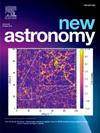Investigation of the correlation between geomagnetic storms and cosmic ray intensity as well as cosmic ray intensity variation with solar wind parameters during three consecutive solar cycles 23, 24, and 25
IF 2.1
4区 物理与天体物理
Q2 ASTRONOMY & ASTROPHYSICS
引用次数: 0
Abstract
A systematic correlation study has been performed in order to establish a significant association between CRI (cosmic ray intensity) and the following parameters: flow pressure, solar wind speed, plasma proton density, solar wind plasma temperature, and IMF (interplanetary magnetic field) for solar cycles 23 and 24, as well as the most recent solar cycle 25. To do this, we used a Chree analysis by superposed-epoch technique to investigate the link between hour-to-hour changes of CRI and the above-mentioned parameters. We found that there is a strong link between CRI and solar wind speed when compared to IMF. This suggests that solar wind speed is a more capable parameter than IMF to cause a decline in CRI. It was observed that for all three solar cycles, there is an inverse correlation between IMF and solar wind speed and a positive correlation between Dst and CRI. We found that solar wind plasma temperature, flow pressure, and plasma proton density have weak correlations with CRI, making them ineffective for CRs (cosmic rays). For all three solar cycles' intense and severe storms, we have discovered a very interesting and adequate result: maximum decline in CRI is observed on the days of minimal Dst (0–11hrs), IMF maximum (0–19hrs), and peak solar wind speed (0–15hrs). We discovered that the instantaneous modulation of CRI is caused by both the solar wind speed and the IMF. Notable behavior was displayed in the years 1999, 2000, 2004, 2014, 2016 2018, and 2023.
23、24、25三个连续太阳活动周期地磁暴与宇宙射线强度的相关性及宇宙射线强度随太阳风参数变化的研究
为了建立宇宙射线强度(CRI)与太阳周期23和24以及最近的太阳周期25的流压、太阳风速度、等离子体质子密度、太阳风等离子体温度和行星际磁场(IMF)之间的显著相关性,进行了系统的相关性研究。为此,我们利用叠历元技术的Chree分析来研究CRI的逐小时变化与上述参数之间的联系。我们发现,与IMF相比,CRI和太阳风速度之间存在很强的联系。这表明太阳风速度是一个比IMF更能引起CRI下降的参数。在三个太阳活动周期中,IMF与太阳风速度呈负相关,Dst与CRI呈正相关。我们发现太阳风等离子体温度、流动压力和等离子体质子密度与CRI的相关性较弱,使得它们对CRs(宇宙射线)无效。对于所有三个太阳周期的强烈和严重的风暴,我们发现了一个非常有趣和充分的结果:在Dst最小(0 - 11小时),IMF最大(0 - 19小时)和太阳风峰值(0 - 15小时)的日子里观察到CRI的最大下降。我们发现CRI的瞬时调制是由太阳风速度和IMF共同引起的。1999年、2000年、2004年、2014年、2016年、2018年和2023年都出现了值得注意的行为。
本文章由计算机程序翻译,如有差异,请以英文原文为准。
求助全文
约1分钟内获得全文
求助全文
来源期刊

New Astronomy
地学天文-天文与天体物理
CiteScore
4.00
自引率
10.00%
发文量
109
审稿时长
13.6 weeks
期刊介绍:
New Astronomy publishes articles in all fields of astronomy and astrophysics, with a particular focus on computational astronomy: mathematical and astronomy techniques and methodology, simulations, modelling and numerical results and computational techniques in instrumentation.
New Astronomy includes full length research articles and review articles. The journal covers solar, stellar, galactic and extragalactic astronomy and astrophysics. It reports on original research in all wavelength bands, ranging from radio to gamma-ray.
 求助内容:
求助内容: 应助结果提醒方式:
应助结果提醒方式:


